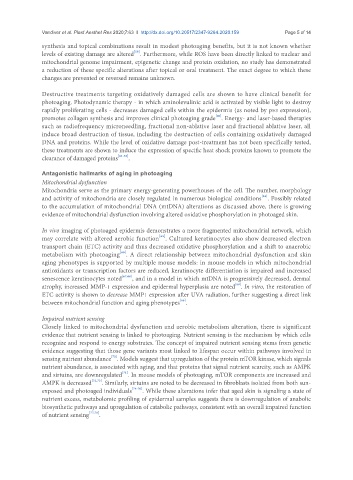Page 741 - Read Online
P. 741
Vandiver et al. Plast Aesthet Res 2020;7:63 I http://dx.doi.org/10.20517/2347-9264.2020.159 Page 5 of 14
synthesis and topical combinations result in modest photoaging benefits, but it is not known whether
[59]
levels of existing damage are altered . Furthermore, while ROS have been directly linked to nuclear and
mitochondrial genome impairment, epigenetic change and protein oxidation, no study has demonstrated
a reduction of these specific alterations after topical or oral treatment. The exact degree to which these
changes are prevented or reversed remains unknown.
Destructive treatments targeting oxidatively damaged cells are shown to have clinical benefit for
photoaging. Photodynamic therapy - in which aminolevulinic acid is activated by visible light to destroy
rapidly proliferating cells - decreases damaged cells within the epidermis (as noted by p53 expression),
[60]
promotes collagen synthesis and improves clinical photoaging grade . Energy- and laser-based therapies
such as radiofrequency microneedling, fractional non-ablative laser and fractional ablative laser, all
induce broad destruction of tissue, including the destruction of cells containing oxidatively damaged
DNA and proteins. While the level of oxidative damage post-treatment has not been specifically tested,
these treatments are shown to induce the expression of specific heat shock proteins known to promote the
clearance of damaged proteins [61-63] .
Antagonistic hallmarks of aging in photoaging
Mitochondrial dysfunction
Mitochondria serve as the primary energy-generating powerhouses of the cell. The number, morphology
[64]
and activity of mitochondria are closely regulated in numerous biological conditions . Possibly related
to the accumulation of mitochondrial DNA (mtDNA) alterations as discussed above, there is growing
evidence of mitochondrial dysfunction involving altered oxidative phosphorylation in photoaged skin.
In vivo imaging of photoaged epidermis demonstrates a more fragmented mitochondrial network, which
[65]
may correlate with altered aerobic function . Cultured keratinocytes also show decreased electron
transport chain (ETC) activity and thus decreased oxidative phosphorylation and a shift to anaerobic
[66]
metabolism with photoaging . A direct relationship between mitochondrial dysfunction and skin
aging phenotypes is supported by multiple mouse models: in mouse models in which mitochondrial
antioxidants or transcription factors are reduced, keratinocyte differentiation is impaired and increased
senescence keratinocytes noted [67,68] , and in a model in which mtDNA is progressively decreased, dermal
[69]
atrophy, increased MMP-1 expression and epidermal hyperplasia are noted . In vitro, the restoration of
ETC activity is shown to decrease MMP1 expression after UVA radiation, further suggesting a direct link
[66]
between mitochondrial function and aging phenotypes .
Impaired nutrient sensing
Closely linked to mitochondrial dysfunction and aerobic metabolism alteration, there is significant
evidence that nutrient sensing is linked to photoaging. Nutrient sensing is the mechanism by which cells
recognize and respond to energy substrates. The concept of impaired nutrient sensing stems from genetic
evidence suggesting that those gene variants most linked to lifespan occur within pathways involved in
sensing nutrient abundance . Models suggest that upregulation of the protein mTOR kinase, which signals
[70]
nutrient abundance, is associated with aging, and that proteins that signal nutrient scarcity, such as AMPK
and sirtuins, are downregulated . In mouse models of photoaging, mTOR components are increased and
[71]
AMPK is decreased [72,73] . Similarly, sirtuins are noted to be decreased in fibroblasts isolated from both sun-
exposed and photoaged individuals [74-76] . While these alterations infer that aged skin is signaling a state of
nutrient excess, metabolomic profiling of epidermal samples suggests there is downregulation of anabolic
biosynthetic pathways and upregulation of catabolic pathways, consistent with an overall impaired function
of nutrient sensing [77,78] .

